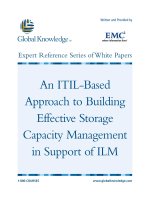An ITIL-Based Approach to Building Effective Storage Capacity Management in Support of ILM
Bạn đang xem bản rút gọn của tài liệu. Xem và tải ngay bản đầy đủ của tài liệu tại đây (165.65 KB, 7 trang )
An ITIL-Based
Approach to Building
Effective Storage
Capacity Management
in Support of ILM
1-800-COURSES
www.globalknowledge.com
Expert Reference Series of White Papers
Written and Provided by
Introduction
Understanding the current state of your storage infrastructure—what capacity you have,
where it is located, who is using it, who is paying for it, how efficiently it is being used, and
how well it is meeting SLAs—is fundamental to intelligently planning, provisioning, and
managing storage. Buying and deploying storage as it is often done on a per-project basis—
based on loose estimates of immediate and future required capacity, application
requirements, and response times—typically results in over-purchasing of hardware and
poor allocation of resources. These are costly mistakes, with less than desired operational
efficiencies, including the risk of outages when storage is simply unavailable.
However, most organizations do not have the tools and processes in place to effectively
gather and track the information necessary to make an informed decision about storage
provisioning. Traditional, manual methods are highly resource- and labor-intensive,
extremely inefficient and costly, and deliver only a subset of information. As a result,
decisions to purchase or configure more storage are most often based on perceived instead of
real needs and expectations, and estimated instead of actual consumption and performance.
The Solution: An ITIL-based Approach
Capacity management is a sub-process within the Information Technology Infrastructure
Library (ITIL) framework that allows companies to quickly, easily, efficiently, and cost-
effectively gather comprehensive information about storage capacity, utilization, and
performance across the enterprise. Utilizing proven processes and solutions that automate
the complex data gathering and analysis process, capacity management helps
organizations set better service level
agreements (SLAs) and more accurately
understand costs for meeting SLAs;
understand costs for setting up an efficient,
profitable recovery mechanism; create a
better financial model; ensure more efficiently
run operations; and ultimately, achieve
information lifecycle management by:
• Ensuring that the need for capacity is
cost-justifiable
• Ensuring more efficient use of resources
• Managing supply against the demand,
especially as it relates to the potential
for providing new services
• Defining IT capabilities proactively to meet
real needs
• Quantifying utilization to predict future
requirements based on previous growth rates
• Building a business case for justifying new
hardware purchases or support consolidation
efforts if capacity requirements are shrinking
• Justifying IT expenditures against ROI
• Performing financial modeling based on
real data
2
Introduction . . . . . . . . . . . . . . . . . 2
The Solution:
An ITIL-based Approach . . . . . . . . 2
Storage Model Considerations . . 3
Implementing Capacity
Management: Getting Started . . 3
Assessment and analysis . . . . . . 3
Rebalancing your
asset portfolio . . . . . . . . . . . . . . . 4
Implementing an
improved asset portfolio . . . . . . 5
Monitoring your
storage environment . . . . . . . . . 6
Summary and Next Steps . . . . . . 6
About the author . . . . . . . . . . . . . 6
Capacity management
enables organizations to:
• Balance capacity and perform-
ance-based requirements more
effectively than traditional
approaches
• Provide greater visibility to net
utilization (actual file system uti-
lization, database-level utiliza-
tion)
• Establish service level capabili-
ties for space utilization and
performance requirements that
can be defined as SLAs by the
service desk
• Provide cost variables for IT
financial management so that
chargebacks for resources allo-
cated can be recovered
• Provide storage resources based
on space as well as performance
needs
• Provide a process to determine
This document presents guidelines and considerations for implementing effective
capacity management capabilities within your organization, using a practical, industry-
proven ITIL-process-based approach for best results. (Performance management, an
important sub-discipline of capacity management, will be addressed separately in a
follow-on white paper.)
Storage Model Considerations
The environment in which you deploy storage can have a significant impact on how
effectively you can manage its capacity and performance. As detailed in the following chart,
a decentralized storage environment makes it difficult to provide adequate storage
resources from the outset, and to manage those resources effectively over time. A
centralized environment, on the other hand, in which a pool of storage resources is
allocated to individual hosts, makes it easier to adjust for growth—even with increased
complexity in balancing capacity and performance utilization.
A payback can often be realized by moving from a decentralized to a centralized
environment. If capacity management has already been implemented in a decentralized
environment, cost savings from a transition will be realized even more quickly.
Implementing Capacity Management: Getting Started
Assessment and analysis
Implementing capacity management begins with a detailed assessment and analysis of
your storage infrastructure in the context of your business drivers. This process establishes
a baseline for actual capacity and performance utilization and allows you to measure the
gap between your current state and your goal (future state). A high-level understanding of
utilization by logical construct (such as business unit, application, or location), and the
capabilities of your infrastructure—as well as the relative importance of each to the other—
will help you find ways to increase utilization levels through re-allocation of resources
instead of simply net-new purchases.
3
Decentralized model
Migration typically incurs downtime,
making it difficult to adjust for growth.
Results in a perceived gross utilization
(allocated vs. host data structures) of
under 50 percent; actual gross
utilization may be even less.
Free space is stranded and cannot be
practically redeployed.
Resources are dedicated to a host,
limiting the amount of resources
available.
Centralized model
Additional storage resources can
usually be provisioned without
incurring downtime, making it easier
to adjust for growth.
Actual gross utilization can exceed 80
percent.
More efficient deployment of resources
yields cost benefits; storage can be
reclaimed or added “on demand”
based on the needs of the business.
Resources are shared, increasing
availability and performance.
By ensuring that you buy the
right amount of assets and
provision them to maximize
use of space and perform-
ance, capacity management
can help you justify your IT
expenditures against ROI.
This is accomplished by:
• Measuring host utilization vs. array utilization
• Mapping resources to specific lines of business or application
• Documenting utilization, both at specific points in time and over a time period (for trending
and modeling)
• Establishing actual utilization of host data structures (file system and database)
The results of this assessment create entries to a logical Capacity Database that gives you a
clear view of both gross and net utilization at the array, host, and across logical levels of
abstraction (i.e., lines of business or application level), providing the metrics for beginning
a rebalancing of your asset portfolio. Best results will be obtained through the use of
storage resource management tools that automate the data collection process and provide
visibility into the relationship of host objects to physical placements, allowing you to query
utilization. A storage management expert can also be an invaluable resource to ensure
delivery of a well-disciplined capacity management process.
Rebalancing your asset portfolio
You will need to create a “blueprint” for rebalancing your asset portfolio that includes:
• A capacity plan focusing on understanding extra capacity and including recommendations
for asset rebalancing (detailing overall utilization, location of wasted space, and challenges
to providing space)
• Capacity reports based on infrastructure level of arrays, hosts, logical entities, and lines of
business/applications
• Initial SLAs and SLRs for capacity and performance (for service level management)
• Initial charging and costing data for financial management (for IT services)
The components of this blueprint should be predicated on a clear understanding ofhow your
IT resources are purchased and how they are utilized. Consider that when infrastructure is
purchased by project, business units whose dollars were spent may not easily give up the
space they bought—even if they are not using it—creating a potentially significant roadblock
to redeploying resources. In a shared/centralized environment where storage resources are
pooled, however, it is understood that resources are shared and allocated where they are
needed, and to the best ability. This is typically the most cost-effective way of doing things;
business units in this type of environment typically recognize that by redeploying storage,
their costs will go down, and future purchases will be less costly.
Rebalancing over-allocated resources to resource-constrained resources is a straightforward
process if the host has not placed the volumes under its control. Your ability to recover over-
allocated storage when the host has awareness of the resources will be affected by the
flexibility of the host operating system, file system, volume manager, and database to
reduce the amount of space allocated. Beware of using percentage-of-utilization as the main
criteria for asset balancing, and use absolute values of allocation as well.
Utilization levels should be reviewed on an ongoing basis and modifications should be
made to your plans as necessary to keep them accurate. Consider implementing software
tools that provide threshold-based alerts for this purpose. Also, implementing tools that
provide automated allocations based on policies will permit more aggressive utilization
levels. Setting up exception-based reports and alerts alleviates the need for manual
inspection, allowing the organization to focus instead on other business and assume
utilization levels are optimum unless otherwise informed of over-utilization,
underutilization, or full-to-capacity status.
4
Implementing an improved asset portfolio
The above deliverables provide the foundation for implementing the necessary changes in
your storage environment to achieve improved utilization and performance. Changes can
include physically moving assets, consolidating assets, and rebalancing your asset
portfolio. This phase involves risk (e.g., potential outages due to reallocation of resources)
and requires additional personnel to perform asset balancing, coordinating resources
across multiple work groups, and justifying changes at the executive level. Critical success
factors include:
• Managing restrictions for space allocation or consolidation—identify and address, up front,
any restrictions that may complicate or impede implementation.
• Coordinating Requests for Change (RFCs) with Change Management.
• Updating the Configuration Management Database (CMDB) with changes to configuration
items (hardware, software, and associated documentation)—this ensures that information is
up-to-to-date and indicative of what your environment looks like so staff working a problem
have accurate information for troubleshooting.
• Providing justification for RFCs in cost savings/avoidance, especially if outages or downtime
are involved—tremendous cost savings can be realized by making a change, but if the
change has a downside (e.g., downtime to host), having dollar justifications will help the RFC
go through if the documented payback is good enough.
An updated capacity plan, incorporating freed-up capacity, should be generated at the
conclusion of this exercise. This will allow you to start forecasting how long your new
capacity will last, based on the data collected to date. It will also allow you to quantify cost
avoidance/savings. For example, did your net utilization go up after moving assets around?
Did improved distribution result in less variability between peaks and lows? This
information will help you quantify any costs avoidance and savings so you can demonstrate
what you brought back into the business. You will now have more time-based data to
evaluate how long that freed-up capacity will last—allowing you to prepare proactively for
your next new purchase.
Monitoring your storage environment
Ongoing monitoring of utilization rates within specific groups in the enterprise is critical—
especially in areas of rapid change and growth. You will need to continuously determine
optimal utilization rates across the enterprise and refine your deployment model as some
areas will be more aggressive than others due to the importance to the business. Look for
areas of excess capacity that remain improperly managed—or areas where a new
application has been deployed and is not fully being utilized. (Keep in mind that utilization
may not be good at first but will improve over time as the organization grows into the
application.) Reevaluate space to determine if it is currently being used, if it ever will be
used, and if you should move it. Measure utilization that is both above and below the
targeted utilization band; under-utilization is acceptable if it is immediately after a large
provisioning process, but reviews should be taken periodically to measure growth in
utilization rates.
You will also need to define processes for handling exceptions to utilization rates, including
provisioning new storage as well as providing additional resources (e.g., ports and
spindles) for performance management; define utilization reporting policies (e.g.,
universal, business unit, application); and provide estimates of when available resources
(e.g., free space, performance envelopes) will be exceeded. If you have done a thorough
analysis and have good data showing what you started with and what you’ve achieved, you
will be able to predict when you will run out of space—and how quickly you need to get
business justification to the executive level for a new storage purchase.
5







